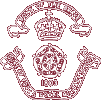


 |
 |
|
 |
||
| Navigation links at the bottom of this page |
Reflections on the Punishment book for 1874 |
As compared with the halfway decade of the Century, that is, the 1850s punishment meted out to wrong-doers was a sinecure. The passage of 24 years showed a number of changes, a minor one being that students changed from having the rank of Private or Pte to Boy or, as recorded in the punishment book Boy or simply B (B to reduce the work of transcribing). The punishments underwent a dramatic change too. In the 1850s boys were still being cast into the 'black hole' for 2, 3 and occasionally 6 days. Cane strokes were liberally administered and, in hopeless cases, boys were drummed out of the school. By 1874, the crimes boys committed were mild and the punishments administered positively liberal. A sample excerpt from the punishment book covering the period 23 – 30 September 1874 records only three types of punishment: four strokes of the cane for one boy; between 2 and 4 hours of extra drill; and loss of 'pay' in the amount of one penny. Regarding the last punishment 'reduction of pay', at age 12, a boy would be paid threepence a month. At 13 years of age, the pay would be fourpence a month, so losing a penny would be a third of a 12-year old's pay and a quarter in the case of a 13-year old boy. These pay estimates might not be correct. They are based on the pay scales for 1939, which are not thought to have changed since 1874. Boys received on penny for each good conduct stripe. [If any boys from the late 1930s would contradict this estimate, they are welcome to contact this site.] Two interesting observations on the offences and punishments for the period reviewed are worth making. Very few offences stemmed from the band or the drum and fife band. The majority came from the Master Shoemaker for either impudence or idleness. One can only conclude from these entries that the Master Shoemaker was a hard taskmaster or strict disciplinarian who brooked no talking while the shoemaker's stuck to their lasts. Sergeant Allan and Corporal Hinton had a number of boys on charge for talking in the ranks. A seven o'clock in the morning – obviously on the breakfast parade – this seems a rather severe code of silence to be maintained in the ranks. The other misdemeanours a various: damaging a flute, fighting, dirtying trousers (wetting, defecating and merely getting them greasy is not defined), throwing stones, not properly cleaning cutlery, and absence from one duty or another are typical and occur throughout the punishment book throughout the entire period of 1874. The punishments are mild enough and far less severe that those imposed by the boy NCOs at a later period. The appearance of Mr. McLeod in the reporting column – for misconduct during school – is likewise and interesting entry. McLeod, along with another scholar, Dr. du Sautoy, was appointed in 1847 to institute a new curriculum and start training schoolmaster sergeants for use throughout the British Army (see http://www.achart.ca/york/schoolmasters.htm) Dr. du Sautoy left in 1859 and McLeod, as Headmaster of the 'Model School' took over management and training of schoolmaster through the 'Normal School' that he and colleague established in 1846. McLeod, a civilian member of staff, retired from his post as Headmaster in 1875 having served the school for 29 years. No headmaster exceeded McLeod's term of service. What little is known of him, McLeod deserved a 'Mr. Chips' if anyone did. He was succeeded by another long-service teacher at the school, Mr. W. G. Lamb who himself retired in 1888. A succession of regular-serving commissioned officers in what eventually became the Royal Army Education Corps (today the Logistical Corps) took over the duties of headmaster. (See the pdf excerpt from the offences and punishments register.) |
| ||||||||||
|
© A. W. Cockerill 2011 Site Map Contact me | ||||||||||